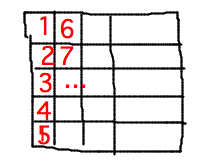SUNY Geneseo Department of Mathematics
Return to List of Lectures
Previous Lecture
Misc
Appointments with me can be for anything, not just grading.
Questions?
Matrices
Sections 8.1 - 8.3
Example. Compare individual guesses about how many legos of various colors are in each of 3 bags to the average of the guesses.
Everyone make a matrix of your guesses by color and bag:
|
Bag 1 |
Bag 2 |
Bag 3 |
| Gray |
|
|
|
| Green |
|
|
|
| Black |
|
|
|
Then gather several tables and calculate an average table.
Reading ideas
- Create 2D arrays using semicolons and brackets
- Access elements with
arrayname( row, column )
- The row and column integers are called “indices”
- Linear indexing can access an element with just 1 index
- Formula for linear index of row r column c in an m-row by n-column array is (c-1)m + r
- Linear indexing counts down consecutive columns

- You can use out-of-range indices to resize an array by assigning a value to an out-of-range element, but out-of-range indexing is an error if you try to read the element at that index
- You can do arithmetic between matrices as long as those matrices have the same number of rows and columns (or a compatible number for matrix multiplication).
Here is some code for creating and averaging matrices, as well as picking an element out with indexing:
>> P = [ 4,5,6 ; 5,6,6 ; 4,5,4 ]
P =
4 5 6
5 6 6
4 5 4
>> G = [ 5,4,8; 4,3,4; 6,9,2 ]
G =
5 4 8
4 3 4
6 9 2
>> E = [ [ 1 2 3]; ...
[ 3,4,5]; ...
[ 5,6,7] ]
E =
1 2 3
3 4 5
5 6 7
>> Avg = (P+G+E) ./ 3
Avg =
3.3333 3.6667 5.6667
4.0000 4.3333 5.0000
5.0000 6.6667 4.3333
>> Avg( 3, 1 )
ans =
5
There are other ways to create matrices, too, as demonstrated here:
>> zeros( 7, 9 )
ans =
0 0 0 0 0 0 0 0 0
0 0 0 0 0 0 0 0 0
0 0 0 0 0 0 0 0 0
0 0 0 0 0 0 0 0 0
0 0 0 0 0 0 0 0 0
0 0 0 0 0 0 0 0 0
0 0 0 0 0 0 0 0 0
>> ones( 7, 9 )
ans =
1 1 1 1 1 1 1 1 1
1 1 1 1 1 1 1 1 1
1 1 1 1 1 1 1 1 1
1 1 1 1 1 1 1 1 1
1 1 1 1 1 1 1 1 1
1 1 1 1 1 1 1 1 1
1 1 1 1 1 1 1 1 1
>> eye( 8 )
ans =
1 0 0 0 0 0 0 0
0 1 0 0 0 0 0 0
0 0 1 0 0 0 0 0
0 0 0 1 0 0 0 0
0 0 0 0 1 0 0 0
0 0 0 0 0 1 0 0
0 0 0 0 0 0 1 0
0 0 0 0 0 0 0 1
>> rand( 4, 8 )
ans =
Columns 1 through 7
0.8147 0.6324 0.9575 0.9572 0.4218 0.6557 0.6787
0.9058 0.0975 0.9649 0.4854 0.9157 0.0357 0.7577
0.1270 0.2785 0.1576 0.8003 0.7922 0.8491 0.7431
0.9134 0.5469 0.9706 0.1419 0.9595 0.9340 0.3922
Column 8
0.6555
0.1712
0.7060
0.0318
Example. Book’s Challenge Activity 8.2.1 (index and return the middle element of an n-by-n array).
Well worth looking at, but it won’t fit on the small projector in the classroom for group work.
What Is Matrix Multiplication? A multiplication rule that associates each element of each row of the first matrix with a row of the second matrix, and multiplies them. You then add the results to get the row in the product corresponding to whichever row of the first matrix you used.

Next
Geometric transformations as matrix multiplication
And a new lab
But no new reading
Next Lecture

